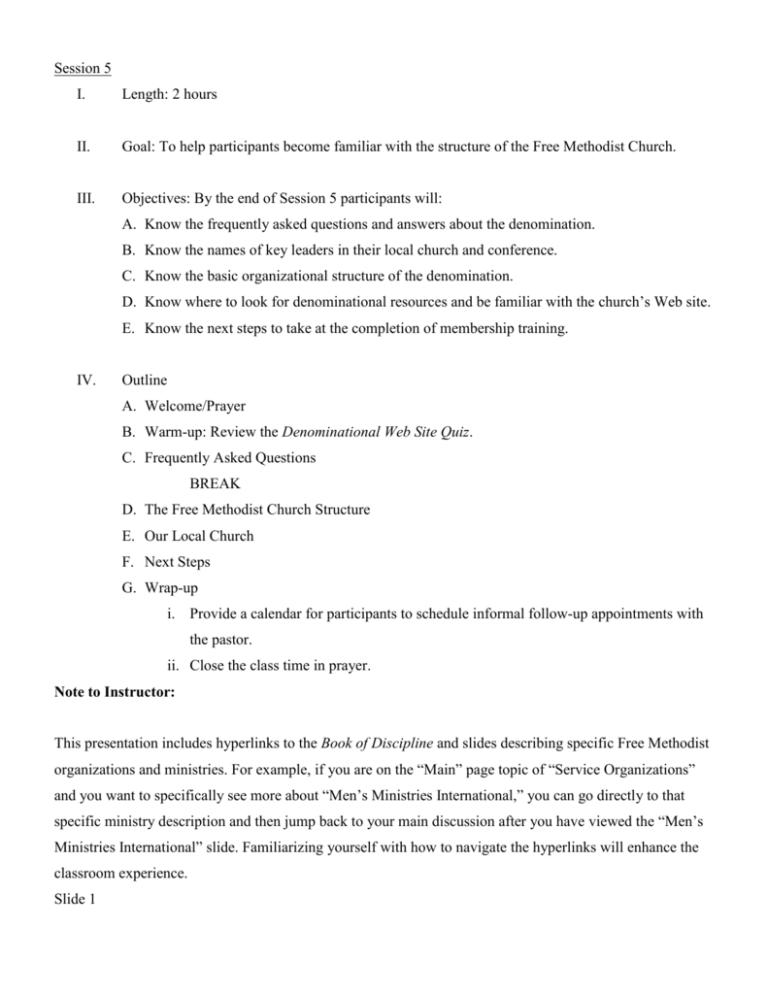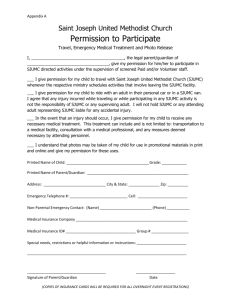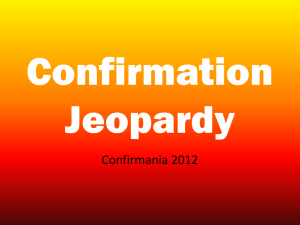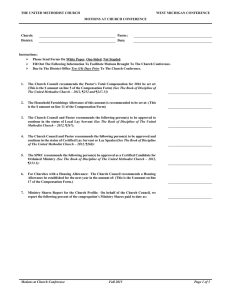Membership 5 – Teaching Notes (Word file)
advertisement

Session 5 I. Length: 2 hours II. Goal: To help participants become familiar with the structure of the Free Methodist Church. III. Objectives: By the end of Session 5 participants will: A. Know the frequently asked questions and answers about the denomination. B. Know the names of key leaders in their local church and conference. C. Know the basic organizational structure of the denomination. D. Know where to look for denominational resources and be familiar with the church’s Web site. E. Know the next steps to take at the completion of membership training. IV. Outline A. Welcome/Prayer B. Warm-up: Review the Denominational Web Site Quiz. C. Frequently Asked Questions BREAK D. The Free Methodist Church Structure E. Our Local Church F. Next Steps G. Wrap-up i. Provide a calendar for participants to schedule informal follow-up appointments with the pastor. ii. Close the class time in prayer. Note to Instructor: This presentation includes hyperlinks to the Book of Discipline and slides describing specific Free Methodist organizations and ministries. For example, if you are on the “Main” page topic of “Service Organizations” and you want to specifically see more about “Men’s Ministries International,” you can go directly to that specific ministry description and then jump back to your main discussion after you have viewed the “Men’s Ministries International” slide. Familiarizing yourself with how to navigate the hyperlinks will enhance the classroom experience. Slide 1 Warm-up — Denominational Web Site Quiz: If you distributed the Web Site Quiz prior to this session, use the warm-up time to give the answers to the quiz. The level of interest participants had with this take-home activity will determine the amount of time you may need to spend in reviewing some of the slides in this session. Slide 2 Slide 3 Free Methodist Membership Training: Session 5 2 U.S. churches — 966 (average congregation size: 76) U.S. members — 73,196 members Worldwide membership — 737,963 in 82 countries Slide 4 Both the United Methodist Church (commonly referred to as Methodist) and the Free Methodist Church share a common heritage, hearkening back to the Wesleyan revival in England during the middle 1700s. Free Methodist Membership Training: Session 5 3 However, by the middle 1800s concern arose over the waning of several key expressions of the Wesleyan revival. The Free Methodist Church began as an attempt to restore vital “Wesleyan” convictions, such as the doctrine of entire sanctification, concern for the poor, a vision to end discrimination and racism, and Christian growth through small groups. Today, there is very little difference between the official doctrinal statements of the United Methodist Church and the Free Methodist Church. Differences become more apparent in church practice and polity (how the church functions and organizes itself). For instance, in the United Methodist Church wider diversity of opinion has been expressed at their General Conference, whereas this has not been the case in the Free Methodist Church. Slide 5 Slide 6 Free Methodist Membership Training: Session 5 4 John Wesley preached that God not only wants His children to take seriously His call to be “justified by faith” (Romans 5:1-2) — thus to be acquitted of their sins and given a whole new start — but He also wants them to take seriously His call to be holy in heart and life (1 Thessalonians 4:1-8). Christians are to be cleansed and empowered by the Holy Spirit so they can live a life of undivided love for God and neighbor. Slide 7 Orthodox — Classical Christianity (Apostles’ Creed). Protestant — Salvation by grace through faith. Evangelical — The Bible is God’s Word and leads to new life through a personal relationship with God through Jesus. Holiness — Enables the believer to love God with all his heart, soul, strength and mind, and his neighbor as Free Methodist Membership Training: Session 5 5 himself. Book of Discipline Distinctive Principles (page 14-15) Free Methodists seek to express the concept of the church of Jesus Christ, their historical perspective and the needs of persons in specific principles and commitments. Free Methodists today seek to continue the mission of first century Christianity which was recovered by John Wesley and the early Methodists who declared they existed “to raise up a holy people.” Free Methodists are a fellowship of Christians in earnest to get to heaven and committed to working in the world for the salvation of all people. They place their commitment to Christ and His church above all others. They keep themselves free from alliances which would compete for their highest loyalty and from all which would encumber and compromise their effective witness to the Trinitarian faith and the believer’s dependence upon the grace of God. The Christian denies himself, takes up his cross daily, and follows Jesus. He conforms to all the will of God as made known in His Word, and believes the conditions of salvation are the same now as they were in the days of the apostles. In doctrine, Free Methodists’ beliefs are the standard beliefs of evangelical, Arminian Protestantism, with distinctive emphasis on the scriptural teaching of entire sanctification as held by John Wesley … Slide 8 Book of Discipline Distinctive Principles (page 14-15) In experience, Free Methodists stress the reality of an inner cleansing and power that attests the doctrine of entire sanctification, both in the inward consciousness of the believer and in his outward life … Slide 9 Free Methodist Membership Training: Session 5 6 Book of Discipline Distinctive Principles (page 14-15) Their worship is characterized by simplicity and freedom of the Spirit, untrammeled by elaborate ritual. Free Methodists maintain a life of daily devotion to Christ that springs from inward holiness and separates the Christian from the world, even while he/she lives in the world. They believe the best way to keep worldliness from invading the church is for the church to invade the world with redemptive purpose. They practice a complete consecration of every power and possession to the service of God and all people everywhere. They believe so strongly in the mission of the church that they are committed to responsible stewardship in finance. Therefore they do not need to resort to commercial efforts to support the cause of Christ. Free Methodists recognize that God gives spiritual gifts of service and leadership to both men and women. Since male and female are both created in the image of God, that image is most fully reflected when both women and men work in concert at all levels of the church. Therefore, all positions in the church are accessible to any whom God has called. Free Methodists sense a special obligation to preach the gospel to the poor. The provisions of the gospel are for all. The “glad tidings” must be proclaimed to every individual of the human race. God sends the true light to illuminate and melt every heart. Jesus set the example. Of His ministry it was reported, “The blind receive their sight, and the lame walk, the lepers are cleansed, and the deaf hear, the dead are raised up, and the poor have the gospel preached to them.” This preaching to the poor was the crowning proof that He was the one who should come. In this respect the church must follow in the footsteps of Jesus. Free Methodists are committed to the New Testament ideals of simplicity and modesty as a style of life. They wish to call attention, not to themselves, but to their Lord. Free Methodist Membership Training: Session 5 7 These distinctives of the Free Methodist Church from its origin are still living issues. In every era and every land these distinctives are the witnesses of the church, needing utterance clear and strong that they may be heard and heeded amidst the world’s confusing and misleading voices. Slide 10 The second part of Session 5 will look at ways the Free Methodist Church is connected. Slide 11 Slide 12 Free Methodist Membership Training: Session 5 8 Local churches are relationally connected to other Free Methodist churches through: Common doctrine Churches are free to pursue the common mission of the church within their own church culture and context. Common administration/oversight Pastors are appointed by overseeing bodies; they are not “called” by local congregations. Common resources Common events Slide 13 The Local Church (called a society) — People come to Christ and grow in Christ through the local church. Free Methodist Membership Training: Session 5 9 The Annual Conference — The annual conference joins local churches into a network within a geographic area. Book of Discipline Annual Conferences, Preamble ¶5000 “Today … the annual conference is the organization at the regional level that joins local churches into a network. The annual conference ensures that pastors and congregations are counseled and encouraged, identifies those who are being called into the ordained ministry and promotes and oversees church planting and evangelism.” Slide 14 Free Methodist Membership Training: Session 5 10 It is called an “annual conference” because it meets once a year to conduct its business, hear reports, receive inspiration and clarify vision. An annual conference is a grouping of churches in a geographic area for purposes of administration, mutual support and growth. The annual conference appoints ministers to local churches. The annual conference is responsible for recruiting ministers, screening ministerial candidates and passing the character of all ministers. Approximately equal numbers of clergy and laity carry out the business of an annual conference. Both the lay delegates and ministerial leaders have equal voting power and the right to speak at the annual conference. This puts into practice a basic principle of Free Methodism that, whenever possible, ministers and lay people work side by side. All local churches send at least one lay [non-pastor] delegate to annual conference. Delegates must be members of the church. Thus each church member has input through elected representatives. Annual conferences support the general church. The annual conferences send representatives to general conference gatherings where important matters are discussed. Annual conferences may be considered the building blocks of the Free Methodist Church. Slide 15 Free Methodist Membership Training: Session 5 11 This slide represents the geographic boundaries that make up each annual conference within the Free Methodist Church of North America. The number of churches within an annual conference may vary from a few to as many as 70 or 80. Ask: What’s the name of our conference? Slide 16 The annual conference offers a variety of services for local churches (training, resources, camps, retreats). Ask: Have you attended any of the conference sponsored events? Slide 17 Free Methodist Membership Training: Session 5 12 The General Conference — The general conference is the primary legislative body of the denomination.* The general conference meets every 4 years and is the denomination’s law-making body. Lay and ministerial delegates have equal voting power and the right to speak on the issues discussed. They provide executive leadership by electing bishops. The general conference elects an interim Board of Administration which meets every 6 months. * Book of Discipline General Conference Free Methodist Church of North America — Purpose ¶4010 A. The general conference shall have general organizational, legislative, judicial, promotional and supervisory powers over the activities of the church. It shall have power to determine the number of its officers, their qualifications for office and the manner of their selection. The general conference is the primary legislative body in the church. It shall have full power to make rules and regulations for the church, under the limitations and restrictions described in ¶210-213. Robert’s Rules of Order in the latest edition shall be the standard of parliamentary procedure in the general conference sessions. Composition ¶4020 The general conference shall be composed of the bishops and an equal number of ministerial and lay delegates to be elected by each annual conference at its last session prior to the session of the general conference, except that conferences held within nine months of the general conference may elect their delegates the year before. Time and Place ¶4060 A. The general conference shall meet every four years at the time and place determined by the general conference (see ¶4320.N). The World Conference — The Free Methodist World Conference joins all general conferences. Slide 18 Free Methodist Membership Training: Session 5 13 The Board of Bishops has primary oversight for U.S. and international conferences as outlined below: Bishop David W. Kendall East Michigan, Gateway, Great Plains, Mid-America, North Central, North Michigan, Ohio, Southern Michigan, Wabash, African Area Annual Conferences; and Coordinator of oversight for the World Ministries Center Bishop David T. Roller Alabama-Georgia, Genesis, Gulf Coast, Keystone, Maryland-Virginia, New England, New South, New York, Pittsburgh, South Atlantic, United Kingdom, and Latin America Area Annual Conferences Bishop Matthew A. Thomas Arizona, Columbia River, Oregon, Pacific Coast Japanese, Pacific Northwest, Rocky Mountain, Sierra Pacific, Southern California, Texas, and Asia Area Annual Conferences Slide 19 Slide 20 Free Methodist Membership Training: Session 5 14 Note: Hyperlink slides are available for each of these departments. Slide 21 Note: Hyperlink slides are available for each of these organizations. Ask: Have you seen these organizations listed in the bulletin or had interactions with any of these? Slide 22 Free Methodist Membership Training: Session 5 15 Note: Hyperlink slides are available for each of these networks. Slide 23 Note: Hyperlink slides are available for each of these institutions. Ask: Do you know anybody that attends these schools? Have you been to any of these institutions? Slide 24 Free Methodist Membership Training: Session 5 16 Slide 25 Note: Hyperlink slides are available for each of these ministries. Ask: Which of these is most familiar to you? Which ones are least familiar to you? Slide 26 Free Methodist Membership Training: Session 5 17 Slide 27 Book of Discipline The Local Church, Preamble ¶6000 A. Mission The mission of the Free Methodist Church is to make known to all people everywhere God’s call to wholeness through forgiveness and holiness in Jesus Christ, and to invite into membership and equip for ministry all who respond in faith. The biblical Great Commission (Matthew 28:18-20; Acts 1:8) commands believers to make disciples in every place and among all peoples. Slide 28 Free Methodist Membership Training: Session 5 18 Give the history of your local church: Founding members (perhaps some still attend or their families attend): Date for when the church started and the circumstances Original buildings Original location Other churches started from your church Other items of interest Note: If you are using the PowerPoint slides with this presentation, you may want to include highlights of the history on a blank slide. You may need to add slides to this presentation — inserting pictures of older buildings or pictures of significant founding leaders. Slide 29 Free Methodist Membership Training: Session 5 19 Review the bulletin or other church publication so participants are familiar with names of church leaders, programs and where to get details about the church community. Pastor: _______________________________________ Church Staff: __________________________________ Church Web site: _______________________________ Church Programs: ______________________________ Slide 30 Share the local church vision with participants. Slide 31 Free Methodist Membership Training: Session 5 20 The previous sessions in this membership course have covered the topics of personal faith in Christ, the meaning of covenant membership, the Articles of Religion, church history, the Christian Journey, and church structure. Church membership is a God-honoring step. When you decide to join in membership, you covenant with the church and God your intentions to “support the church, to live in fellowship with the members …, to be an active participant in the ministry of the church, and to seek God’s glory in all things;”* Book of Discipline Membership, Privileges and Requirements ¶151 The requirements of full membership are: A. Christian baptism, confession of a personal experience in regeneration, and a pledge to seek diligently until sanctified wholly if that experience has not been attained; B. acceptance of the Articles of Religion, the Membership Covenant, the goals for Christian conduct and matters of church government as written in the Book of Discipline; [1] *C. a covenant to support the church, to live in fellowship with the members thereof, to be an active participant in the ministry of the church, and to seek God’s glory in all things; D. approval of membership by the local board of administration and the candidate’s public declaration of membership vows. Slide 32 Free Methodist Membership Training: Session 5 21 Plan to meet with the pastor to discuss any follow-up questions you have regarding membership and to discuss your intentions about membership. Once you decide to join in membership, the local board of administration will need to formally vote on your approval. Upon approval from the local board of administration, a time will be planned to publicly affirm your faith and your desire for membership. Slide 33 Hyperlink Slides Free Methodist Membership Training: Session 5 22 The following pages are hyperlink slides that can be referred to during the teaching time. They are included here for your benefit in familiarizing yourself with this resource. It is not necessary to go through each of these slides; use them as appropriate for your setting. Some slides may be of more interest than others. Slide 34 Slide 35 Slide 36 Free Methodist Membership Training: Session 5 23 Slide 37 Slide 38 Free Methodist Membership Training: Session 5 24 Slide 39 Slide 40 Free Methodist Membership Training: Session 5 25 Slide 41 Slide 42 Free Methodist Membership Training: Session 5 26 Slide 43 Slide 44 Free Methodist Membership Training: Session 5 27 Slide 45 Slide 46 Free Methodist Membership Training: Session 5 28 Slide 47 Slide 48 Free Methodist Membership Training: Session 5 29 Slide 49 Slide 50 Free Methodist Membership Training: Session 5 30 Slide 51 Slide 52 Free Methodist Membership Training: Session 5 31 Slide 53 Slide 54 Free Methodist Membership Training: Session 5 32 Slide 55 Slide 56 Free Methodist Membership Training: Session 5 33 Slide 57 Slide 58 Free Methodist Membership Training: Session 5 34 Slide 59 Slide 60 Free Methodist Membership Training: Session 5 35 Slide 61 Slide 62 Free Methodist Membership Training: Session 5 36 Slide 63 Slide 64 Free Methodist Membership Training: Session 5 37 Slide 65 Slide 66 Free Methodist Membership Training: Session 5 38 Slide 67 Slide 68 Free Methodist Membership Training: Session 5 39 Slide 69 Slide 70 Free Methodist Membership Training: Session 5 40 Slide 71 Slide 72 Free Methodist Membership Training: Session 5 41 Slide 73 Slide 74 Free Methodist Membership Training: Session 5 42 Slide 75 Slide 76 Free Methodist Membership Training: Session 5 43 Slide 77 Slide 78 Slide 79 Free Methodist Membership Training: Session 5 44 Slide 80 Slide 81 Free Methodist Membership Training: Session 5 45 Slide 82 Free Methodist Membership Training: Session 5 46


